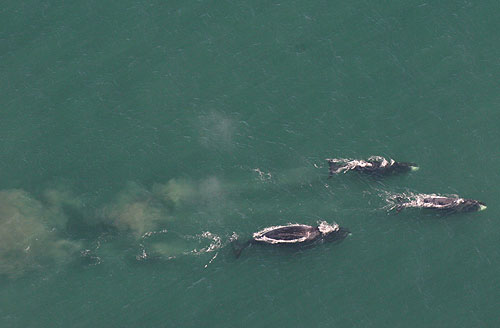 Alaska Science
Autumn waters north of Barrow
heavy with whales
Alaska Science
Autumn waters north of Barrow
heavy with whales
By Ned Rozell
September 23, 2010
Thursday
Attracted by some of the smallest creatures in Alaska, dozens
of the state's largest gathered last week off Point Barrow.
Bowhead whales in groups of almost 100 were grouped a few tens
of miles from Barrow to take advantage of one of the richest
whale feeding hotspots off the coast of Alaska. Steve Okkonen
was there to see them in the shallow waters above the continental
shelf north of Barrow.
 Three bowhead whales
feeding north of Barrow on large concentrations of krill.
Three bowhead whales
feeding north of Barrow on large concentrations of krill.
NOAA photo by Craig George
"The whales we saw Friday and Saturday were in eight meters
of water," said Okkonen, a research associate professor
with the University of Alaska Fairbanks School of Fisheries and
Ocean Sciences. "That's an eight-meter (-long) animal in
eight meters of water, sometimes up to a 15-meter animal in eight
meters of water."
The creatures, weighing more than 100 bull moose, were congregating
off Point Barrow because of a staggering concentration of one
of their favorite foods, krill. Krill, shrimplike organism about
an inch long, are so small it would take a few hundred to fill
a cereal bowl. Okkonen and researchers from Woods Hole Oceanographic
Institution, the University of Rhode Island, the North Slope
Borough and others are studying the Barrow whale-feeding hotspot
to determine how unique and important it is, a question developers
will be
forced to ponder when considering which areas to alter in the
search for oil and gas.
From the Annika Marie, a 43-foot research ship, Okkonen and his
colleagues witnessed a phenomenon common offshore of Barrow in
the fall. Strong east winds help create a current that forces
krill toward the shallow continental shelf from the depths of
the Beaufort Sea. These east winds also push the krill-infested
waters westward along the Beaufort coast toward Point Barrow.
When the east winds settle down, another current flowing northeastward
up the Chukchi Sea coast acts as a wall.
"The krill will tend to stack up," Okkonen said.
Sometimes swimming in an echelon formation reminiscent of migrating
geese, bowhead whales plow through the stacks of krill, filling
their bathtub-size bellies with tens of thousands. Okkonen and
his coworkers want to find out how the Barrow hotspot compares
to other great feeding areas along the whales' annual migratory
path through cold northern waters. Bowheads spend their entire
lives in the Bering, Chukchi, and Beaufort seas.
"In Alaska (the Point Barrow area) is the hotspot, but how
important is that spot?" Okkonen asked, adding that areas
off Camp Simpson and Kaktovik are also productive for whales.
"We also want to find out if krill overwinter (off Point
Barrow after the sea ice forms)."
Point Barrow is an important place for bowhead whales, which
pass it during spring as they move from the northern Bering Sea
to where they spend their summers in the Canadian arctic. Barrow-area
Natives have harvested bowheads in both spring and fall for thousands
of years.
Researchers including Okkonen wrote a paper detailing the Barrow
hotspot and the prevalence of bowheads in the June 2010 issue
of Arctic. Here is their conclusion: "Because . . . whales
appear to persist despite ongoing climate variability, the fall
whale harvest by the Inupiat community at Barrow should be relatively
resilient to climate change. The whale harvest at Barrow could,
however, be particularly vulnerable to anthropogenic activities
such as ship traffic, oil development, or an oil spill."
This column is provided
as a public service by the Geophysical Institute,
University of Alaska Fairbanks, in cooperation with the UAF research
community.
Ned Rozell [nrozell@gi.alaska.edu]
is a science writer at the institute.
E-mail your news &
photos to editor@sitnews.us
Publish A Letter in SitNews Read Letters/Opinions
Contact the Editor
SitNews
©2010
Stories In The News
Ketchikan, Alaska
|

